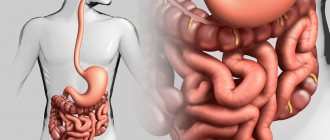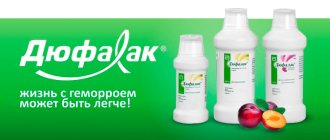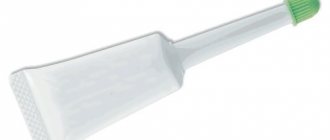Updated: 01/31/2021 21:52:43
*Review of the best according to the editors of expertology.ru. About the selection criteria. This material is subjective in nature, does not constitute advertising and does not serve as a purchase guide. Before purchasing, consultation with a specialist is required.
Digestive discomfort, which is commonly called “colic,” is observed in more than half of newborns up to 6 months of age. Sometimes only this pain-spastic syndrome is present. But colic is often accompanied by other unpleasant digestive disorders - frequent regurgitation, constipation.
The cause of this condition may be the immaturity of the baby’s gastrointestinal tract and disturbances in the composition of the intestinal microflora - dysbacteriosis. Or they are provoked by more serious conditions - allergies or hypersensitivity to cow's milk proteins. In this case, you cannot do without consulting a pediatrician.
To solve the problem, a specialist may prescribe special mixtures, which are divided into the following categories:
- hypoallergenic;
- fermented milk;
- with antireflux effect;
- prebiotic and probiotic.
To help young parents, this review will consider the best mixtures for constipation and colic for newborns from imported and domestic manufacturers.
Causes of constipation in newborn babies
In more serious cases, difficulties with stool cause intoxication of the body with waste products, disrupt metabolism, and increase the risk of developing infections, allergic reactions and other diseases.
The appearance of constipation is associated with the physiological characteristics of the gastrointestinal tract of the newborn and its adaptation to the outside world. The immaturity of the baby’s gastrointestinal tract in the first months of life is expressed in insufficient production of enzymes and weak muscle apparatus, which in turn leads to the formation of such problems as:
- imbalance of intestinal microflora;
- difficulty digesting food due to insufficient enzymes;
- weak peristalsis of the stomach and intestines, causing stagnation of feces.
Factors contributing to constipation are:
- poor nutrition of the mother during breastfeeding;
- violation of the diet and incorrect introduction of formulas during complementary feeding and artificial feeding;
- insufficient amount of fluid entering the body;
- keeping the baby in a horizontal position for a long time;
- immobility of the baby;
- abrupt termination of breastfeeding and transition to adapted formulas;
- high fever, colds or infectious diseases;
- treating the mother or baby with antibiotics, antispasmodics, anticonvulsants and other medications that cause constipation.
Which brand is better to choose a mixture for constipation and colic for newborns?
You can use special baby formulas for colic and constipation not only in case of artificial feeding, but also as an additional nutrition to breastfeeding. Many well-known manufacturing companies have such products, but the following were able to get into the latest rating:
- Nestle is a Swiss company that has been around for over a hundred years. It has two brands of baby food - Nestogen, NAN. Each composition is optimized for a specific age range; in addition to vitamins, it contains carbohydrates, proteins, and fats in the right proportions.
- Agusha is a Russian baby food brand that has existed since 1992. Today this brand is the main supplier of food to free dairy kitchens. The maximum expansion of the range has been observed since 2008. The company strives to unify its products and become recognizable not only within Russia.
- Bibikol is a German manufacturer that uses New Zealand raw materials to produce baby food. It is in these regions that valuable goat milk is obtained, since the animals eat fresh grass all year round. The company does not offer combined feeds; they do not contain GMOs, fragrances or additives.
- Humana is the only manufacturer whose entire production process takes place in Germany. The raw material used is milk only from family farmers in the city of Herford. The safe composition and wide range have earned the trust of millions of customers.
- Similac is a well-known brand of baby food, owned by the American company Abbott. It occupies a leading position in its market segment. The composition of infant formula is maximally adapted to breast milk, which protects the fragile digestive system from disorders.
- Friso is a Dutch company with more than 19,000 farms producing natural baby food. Experience has exceeded 130 years. The Queen of Holland awarded the company royal status. Each product contains an optimal combination of key nutrients for the baby’s immunity.
How to deal with constipation in the first months of a baby's life
Before taking any measures against constipation, it is necessary to have a correct understanding of what are signs of constipation and what can be attributed to the physiological norm.
Signs of constipation:
- 1 - stool less than once a day
- 2 - lack of appetite
- 3 - bloating
- 4 - sleep disturbance, general restlessness, moodiness
- 5 - gases with the smell of rot
- 6 - dense stool streaked with blood
- 7 - slow weight gain
The above symptoms may appear separately or in combination. The presence of constipation in a child can be definitively determined by assessing the general physical condition and well-being. If your baby has a good appetite and weight gain is normal, there is no serious cause for concern.
Colic or gas - what's the difference?
In the intestines of a newborn, food is not completely digested. Some of the milk settles on its walls, and fermentation begins. Air bubbles form, the tummy swells and becomes hard. This worries the baby - he grunts, farts often, and can be capricious. Most often this happens during feeding.
The formation of gases does not pose any problem. We must ensure that there is no constipation and that the baby does not overeat. Over time, the digestive system will become stronger. The necessary enzymes will be produced in sufficient quantities, and the problem with gases will go away.
Gas is one of the causes of painful sensations in the tummy - colic. They cannot be confused with anything. The child screams non-stop and cannot be calmed down.
This occurs because a large amount of gases put pressure on the intestinal walls and cause spasms, which are very painful for the child.
How to help your baby with constipation?
For a breastfed baby, proper nutrition of the mother is of the greatest importance. If the baby has problems with bowel movements, the mother is recommended to introduce into her diet foods that have a laxative effect: prunes, beets, fresh plums and apricots, kefir and other fermented milk products. In this case, it is also useful to increase the volume of fluid consumed.
It is recommended to exclude from the diet foods that can contribute to constipation:
- foods with excess protein content;
- rich broths;
- thick viscous porridges, especially rice and millet;
- pasta and flour products;
- refined products;
- strong tea and coffee.
To increase muscle tone and improve intestinal motility, pediatricians recommend regular massage of the tummy in the navel area (with a warm hand in a clockwise direction), as well as placing the baby on the tummy. Gymnastics for the abdomen are useful - exercises such as “bicycle” and “frog” (pressing the legs to the stomach).
Applying a warm diaper to the tummy also helps stimulate intestinal motility.
Medicinal mixtures in the nutrition of infants
Therapeutic nutrition is a powerful therapeutic factor, in which a properly formulated diet becomes a key mechanism that allows you to influence disrupted parts of metabolism, normalize the functions of the digestive system, and activate the body’s defenses, which largely determines the course and outcome of the disease. For certain types of pathology, nutritional therapy is the only means of treatment.
To organize therapeutic nutrition for a sick child in the first year of life, the correct choice of a product with a special specified composition that meets the characteristics of the disease and the nature of the metabolic processes disturbed is important.
Currently, in our country there is a wide range of specialized products for therapeutic and prophylactic purposes, produced domestically and abroad, for the nutritional correction of various diseases in infants.
Specialized mixtures for children with functional disorders of the gastrointestinal tract
In recent years, anti-reflux milk formulas have been widely used in the nutrition of infants with regurgitation, vomiting, and constipation [1, 2]. Depending on the type of thickener, they are divided into two groups: mixtures containing carob gum (Nutrilak AR, Nutrilon AR, Frisovom, Humana AR) or starch (Samper Lemolak, Enfamil AR ", "Nutrilon Comfort") (Table 1).
The protein component of most of the listed antireflux products is dominated by whey proteins, which are easily digested and removed from the stomach relatively quickly. The only casein-predominant mixture is Nutrilon AR. Casein forms a denser clot in the stomach, which can prevent regurgitation and enhances the effect of the gum. In addition, this mixture has a moderately reduced fat content (3.1 g/100 ml), which promotes faster evacuation of food from the stomach.
Locust bean gum is a soluble, starch-free polysaccharide that swells in the baby's stomach, thereby preventing regurgitation. The carbohydrates that make up the gum are dietary fiber - indigestible polysaccharides that are not broken down in the upper gastrointestinal tract, but are fermented by colon microorganisms, promoting the selective growth of indigenous microflora.
The maximum permissible gum content in the product is 1 g per 100 ml. In antireflux mixtures, the gum content ranges from 0.34 to 0.5 g per 100 ml. Edible gum is divided into instant (instant) and natural (requiring dilution with hot water for swelling), obtained from the seeds of the Mediterranean acacia and containing 85% carbohydrates, 5% protein, 10% moisture.
Depending on the type of gum added to the product, the water temperature for diluting anti-reflux mixtures is different and is: for products containing instant gum, 40–50 ° C (“Humana AR”, “Nutrilak AR”, “Nutrilon AR”); for products with natural gum, significantly higher than 70–80°C (“Frisov 1” and “Frisov 2”).
Anti-reflux products containing gum are introduced into the child’s diet gradually, at each feeding. It is possible to add them to a bottle with standard formula that the child receives, but it is more effective to use them independently at the beginning of feeding. The volume of the medicinal product is selected individually until regurgitation stops.
The second group of anti-reflux products consists of mixtures containing rice, corn or potato starch, rich in amylopectin, as a thickener (Samper Lemolak, Enfamil AR, Nutrilon Comfort 1 and Nutrilon Comfort 2). Amylopectin is a high-molecular compound - a branched polymer of glucose, the digestion of which is slow. Its breakdown occurs primarily in the small intestine under the action of glycoamylase. Amylopectin does not have prebiotic properties.
Antireflux formulas are primarily used for regurgitation (spitting up) in infants. Regurgitation is the return of food chyme after swallowing the food eaten. Regurgitation is often caused by inadequate feeding (rapid sucking, aerophagia, overfeeding, feeding irregularities, inadequate choice of formulas), as well as perinatal lesions of the central nervous system, pylorospasm, etc. Therefore, the prescription of antireflux formulas should be preceded by identifying the causes of regurgitation [3].
Mixtures containing gum can also be used in the nutrition of children with functional constipation: chronic delay in bowel movement for more than 36 hours, increased intervals between bowel movements compared to the physiological norm, difficulty in defecation, and the passage of small amounts of high-density feces. It is known that gum has the properties of dietary fiber: it retains additional amounts of water and helps to gently stimulate intestinal motility, which leads to the elimination of constipation. The most effective of this group of products are mixtures with a predominance of whey fraction in the protein component, since caseins have a fixing effect. When treating constipation, milk mixtures with gum can not be introduced into every feeding, but independently as a separate feeding - 2-3 times a day [3].
In addition to mixtures that contain gum, the “Samper Bifidus” mixture containing lactulose has proven itself well in the nutrition of children with constipation (Table 2). Lactulose is a disaccharide consisting of galactose and fructose, obtained synthetically. It, like dietary fiber, is not digested by enzymes of the gastrointestinal tract; it reaches the colon unchanged, where it is fermented by lacto- and bifidobacteria and serves as a substrate for their growth. During the fermentation process, short-chain fatty acids are formed, the pH of the intestinal contents decreases and osmotic pressure increases, resulting in fluid entering the intestinal lumen, increased peristalsis and elimination of constipation [4].
Currently, “Agusha Baby Milk with Lactulose” is produced (OJSC “Children's Dairy Products Plant”, Russia), which is recommended for use in the nutrition of children with functional disorders of the gastrointestinal tract.
In addition to children's dairy products, lactulose is included in the composition of children's instant cereals "Nutrilak. Corn with lactulose", "Nutrilak. Oatmeal with lactulose" (Nutritek, Russia). These products are effective in feeding sick children with impaired intestinal motor function (constipation, unstable stool).
The formation of softer stools is also facilitated by dietary fiber - oligosaccharides, which are linear polymers of glucose and other monosaccharides (galactose, fructose). In human milk, galactooligosaccharides account for 12–14% of the total carbohydrates. They have a prebiotic effect, ensuring the growth of bifidobacteria in the child’s intestines. A prebiotic supplement containing 90% short-chain galactooligosaccharides and 10% long-chain fructooligosaccharides, which is part of the mixtures “Nutrilon Comfort 1” and “Nutrilon Comfort 2”, has similar properties [5].
Low-lactose and lactose-free mixtures
Low- and lactose-free infant formulas include products created on the basis of cow's milk proteins and intended for feeding children of the first year of life with lactase deficiency.
In lactose-free mixtures, the amount of lactose (milk sugar) is almost zero. The main carbohydrate component of such mixtures is dextrin-maltose. Low-lactose formulas contain approximately 1 g of lactose per 100 ml (0.9 to 1.33 g), compared to 6 to 7 g of lactose per 100 ml in human milk and standard formulas.
As a rule, in low- and lactose-free formulas the ratio of whey proteins to casein is 60:40 or 50:50, and the fat component is represented by a composition of vegetable oils, which is typical for adapted infant formulas and allows them to be recommended for use from the first days of a child’s life. Predominantly “casein” formulas include mixtures of “Humana-LP” with prebiotics: galacto-oligosaccharides, dietary fiber and “Humana-LP + MCT” (ratio of casein to whey fraction 80:20). The content of prebiotics (galacto-oligosaccharides, fiber) in combination with a low fat content gives rise to the use of these mixtures for the correction of diarrhea syndrome in lactase deficiency (Table 3) [6].
Hypolactasia or alactasia are diseases resulting from insufficient activity or complete absence of the parietal digestive enzyme, lactase, which breaks down milk sugar (lactose), which are manifested by osmotic (“fermentation”) diarrhea after taking lactose-containing dairy products [7].
Diet therapy is the main method of treating lactase deficiency. It is aimed at “bypassing” the metabolic block. The use of low- and lactose-free formulas in the nutrition of children with lactase deficiency allows us to provide a pathogenetic approach to the treatment of this pathology.
In case of primary (constitutional) lactase deficiency, a low-lactose (lactose-free) diet is prescribed for life. In case of secondary lactase deficiency, the main attention is paid to the treatment of the pathology that led to this condition, and limiting lactose in the diet is temporary, but a necessary measure.
When artificial feeding, a mixture with the maximum amount of lactose that the patient can tolerate should be selected, without allowing the appearance of clinical symptoms and increased excretion of carbohydrates in feces. This is due to the fact that lactose is the only source of galactose, which is formed during its breakdown. Galactose is used for the synthesis of galactolipids, including cerebrosides, which are necessary for the formation of the central nervous system and myelination of nerve fibers. In addition, it is believed that daily consumption of small amounts of lactose is necessary for the intestinal microflora to adapt to it and maintain normal intestinal microbiocenosis. Lactose-free products are prescribed only for severe forms of lactase deficiency, when the use of low-lactose mixtures is ineffective.
In some cases, lactose-free products can be temporarily introduced during breastfeeding, when the administration of the lactase enzyme is ineffective and lactose restriction is necessary. Prescribing lactose-free formulas (as opposed to low-lactose products) allows us to maintain the use of mother's milk to the maximum possible extent.
Dietary correction for lactase deficiency consists of gradually replacing infant formula with a low-lactose or lactose-free product, which is introduced into each feeding. The required volume of the therapeutic mixture is determined by clinical symptoms: if it is possible to eliminate diarrhea and colic by combining a low-lactose or lactose-free formula with a standard milk formula, the latter should not be completely canceled [8].
Fermented milk mixtures and products
Fermented milk products occupy an important place in the therapeutic nutrition of children in the first year of life, as they have a beneficial effect on the secretory activity of the digestive tract, intestinal motility, have an inhibitory effect on pathogenic microorganisms, stimulate the growth of indigenous microflora, help improve the absorption of calcium, phosphorus, magnesium and iron, have an immunomodulatory effect and increase the body’s defenses [2, 6, 9].
Inhibition of the growth of pathogenic microorganisms when using fermented milk mixtures occurs due to the production of antimicrobial substances, competition for nutrients, and obstacles to the adhesion of pathogenic flora to enterocyte receptors. The immunomodulatory effect of these products is to enhance phagocytosis, activate the proliferation of lymphocytes, prevent the degradation of secretory immunoglobulin A, stimulate the production of interferon, lysozyme, properdin, influence the cytokine system, and regulate the production of interleukins.
If fermented milk products contain live microorganisms (bifidobacteria and lactobacilli) - representatives of the normal microflora of the human intestine, then they are called probiotic products. They have a double functional effect due to the presence of probiotic strains of microorganisms and the lactic acid they produce.
When developing probiotic products, various types of microorganisms are used, mainly bifidobacteria and lactobacilli, which, as well as products created on their basis, are subject to strict requirements regarding safety, functional efficiency, and manufacturability [10].
The basic requirements for the safety of the product and its components are formulated in the sanitary legislation of the Russian Federation, as well as in the international recommendations of the FAO/WHO and consist in the use of strains of microorganisms isolated from humans; absence of pathogenicity, toxicity and adverse reactions, antibiotic resistance, high adhesive properties to the epithelium of the intestinal mucosa, stability of the genetic code [11, 12].
Each strain of bifidobacteria has its own characteristics and range of action. Thus, Bifidobacterium (B.) bifidum and B. infantis predominate in the intestines of breastfed children, and B. adolescentis predominates in bottle-fed children. Recently, strains of B. lactis (Bв 12), which have pronounced functional activity and good stability in the gastrointestinal tract of a child, have been widely used to obtain fermented milk mixtures with probiotic properties.
Lactobacilli are more often used in combined starter cultures when creating fermented milk products. It is known that lactobacilli Lactobacillus (L.) acidofilus, L. rhamnosus (LGG), L. casei have good preservation in the product, resistance to external influences, and a high probiotic effect (Table 4).
Fermented milk products can be liquid or dry; they are also divided into adapted and non-adapted (Table 5).
Liquid adapted fermented milk mixtures "Agusha 1" and "Agusha 2" (JSC "Children's Dairy Products Plant", Russia) are intended for use in the nutrition of children of the first year of life. The product "Bifilin" and the acidophilic mixture "Malyutka" are partially adapted fermented milk mixtures. The protein content in them is 1.7 g per 100 ml of liquid product, and the ratio of albumin and casein fractions is 20:80, as in cow's milk.
Unadapted liquid dairy products include “Tema. Fermented milk drink with Bv12" (JSC "UNIMILK", Russia), as well as "Narine", "Biolact", "Biokefir", "Bifidokefir", "Bifidok", which are produced in children's dairy kitchens or in baby food shops. They are used in the nutrition of children from 8 months [13].
The Russian consumer market also has liquid fermented milk probiotic products “Activia” and “Actimel” (Danone, France), intended for children over 3 years of age.
What is new in pediatric dietetics is the creation of dry adapted fermented milk mixtures (Table 6).
When using fermented milk products in children of the first year of life, there is a decrease in the severity of functional disorders of digestive processes, such as colic, a tendency to constipation, dyspeptic symptoms, decreased appetite, as well as an improvement in the composition of the intestinal microflora. These products are used in infants at risk of developing nutrition-related diseases, as well as those suffering from rickets, anemia, and malnutrition. At the same time, a higher digestibility of iron and an increase in the level of hemoglobin in children with anemia, an improvement in the processes of osteogenesis in children with rickets and a more pronounced increase in body weight in children with malnutrition were noted, which is due to the high digestibility of protein, calcium and iron from them [3, 4, 13].
Hypoallergenic products based on milk protein hydrolysates
The emergence of mixtures created on the basis of milk protein hydrolysates marks the beginning of a new era in the prevention and treatment of food allergies, as well as a number of serious diseases accompanied by impaired intestinal absorption syndrome and a decrease in the nutritional status of the child [14].
Depending on the degree of breakdown of milk protein, mixtures are isolated based on its complete (high) or partial (moderate) hydrolysis. Both casein and whey fractions of milk proteins can undergo hydrolysis.
Casein mixtures based on milk protein hydrolysates (depending on the initial milk raw materials) include Nutramigen, Pregestimil, Frisopep AS. Whey products include “Damil Pepti”, “Nutrilak GA”, “Nutrilak Peptidi SCT”, “Nutrilon Pepti TSC”, “Nutrilon GA 1” and “Nutrilon GA 2”, “Alfare”, “NAN GA 1” and “NAN GA” 2", "Frisopep", "HiPP GA 1" and "HiPP GA 2", "Humana GA 1" and "Humana GA 2".
It has been established that the higher the molecular weight of the hydrolyzate peptides, the greater the risk of developing allergic reactions. Compared to cow's milk protein, the allergenicity of the protein component of products created on the basis of highly hydrolyzed protein is reduced by 10,000–100,000 times, and partially hydrolyzed by 300–1000 times. The molecular weight of peptides at which the allergenicity of the hydrolyzate becomes minimal is 1.5 kDa; peptides with a molecular weight of 3–3.5 kDa can in some cases cause allergic reactions.
All mixtures of this class are enriched with a complex of vitamins and minerals in accordance with the physiological needs of children in the first year of life and comply with WHO requirements for ingredient composition, biological and nutritional value, and influence on the physical and psychomotor development of children in the first year of life [15].
In accordance with the clinical purpose, mixtures based on milk protein hydrolysates are divided into therapeutic, therapeutic-prophylactic and prophylactic (Table 7).
Medicinal mixtures include only mixtures obtained as a result of deep hydrolysis of milk protein, which, as a rule, are semi-elemental, since in addition to the modified protein component they contain medium-chain fatty acids, monosaccharides, glucose polymers and are completely devoid of lactose. These products are intended for children with severe manifestations of food allergies caused by hypersensitivity to cow's milk proteins and other food proteins, as well as patients with maldigestion and malabsorption syndrome due to celiac disease, pancreatic insufficiency, dystrophy of the intestinal mucosa, after resection of sections of the small intestine, etc.
Knowledge of the characteristics of the lipid and carbohydrate composition of various medicinal mixtures created on the basis of highly hydrolyzed milk protein allows you to select the optimal product depending on the clinical manifestations in each specific case. The lipid component of the mixtures “Alfare”, “Nutrilak Peptidi MCT”, “Nutrilon Pepti TSC”, “Pregestimil” contains medium chain triglycerides (up to 50% of the total amount of lipids), which are easily broken down, do not require emulsification by bile and the participation of pancreatic lipase, and are absorbed into the portal vein system, bypassing the lymphatic vessels. These products are indicated for patients with severe gastrointestinal manifestations of food allergies and malabsorption syndrome.
When using medicinal protein hydrolysates, it is possible to achieve a significant improvement in skin and gastrointestinal manifestations within 2–3 weeks from the start of their use, and clinical remission after another 2–3 months. At the same time, in children with underweight, the nutritional status is normalized. The duration of use of these products is individual, on average it is 3–4 months or more.
When choosing a specialized product based on protein hydrolyzate, it is also necessary to take into account the presence or absence of lactose in its carbohydrate component, since secondary lactase deficiency often accompanies food hypersensitivity, in such cases it is advisable to use medicinal mixtures that do not contain lactose (Nutramigen, Frisopep AS ").
Hypoallergenic mixtures with partially (moderately) hydrolyzed milk protein (“NAN GA 1” and “NAN GA 2”, “Nutrilon GA 1” and “Nutrilon GA 2”) are intended only for the prevention of allergic diseases in children at high risk for the development of atopy transferred to mixed or artificial feeding.
The peptide profile and low residual allergenicity of such mixtures as "Damil Pepti", "Nutrilak GA", "HiPP GA 1" and "HiPP GA 2", "Humana GA 1" and "Humana GA 2" allow their use not only in for preventive purposes, but also for the treatment of mild forms of allergy to cow's milk proteins that occur without the participation of immunoglobulin E-mediated mechanisms [16].
All products created on the basis of milk protein hydrolysates have a bitter taste and a specific odor; when prescribed during the adaptation period, slightly thin and frequent stools, greenish or brown in color, are possible, which should not serve as a reason for discontinuing the product.
Soy protein isolate based mixtures
Modern soy formulas are developed on the basis of soy protein isolate, in which the protein content is more than 90%, and undesirable components (indigestible carbohydrates, trypsin inhibitor, lectins and saponins) are removed during the technological production. No genetically modified soy is used in the production of soy formulas for baby food.
The biological value of soy protein isolate is increased due to the additional introduction of L-methionine and other amino acids and is comparable to milk casein. The fat composition of soy mixtures is represented by a mixture of vegetable fats, and carbohydrates consist of dextrin-maltose and corn starch (Table 8). Thus, all soy formulas are dairy-free and lactose-free.
Mixtures based on soy protein isolate are enriched with a vitamin and mineral complex, and the use of modern technologies allows for increased absorption of calcium, phosphorus and iron.
Mixtures based on soy protein isolate can be used quite effectively in the treatment of food allergies induced by cow's milk proteins. However, clinical observations show that in 20–25% of children in the first year of life they can cause the onset or exacerbation of atopic dermatitis or gastrointestinal manifestations of allergies. Our studies indicate that most often allergic reactions develop with the rapid (within 1–2 days) introduction of soy mixtures, their early administration (to children in the first months of life), and a burdened allergic history [14, 17].
To prevent the development of an undesirable effect when using soy mixtures in children, certain conditions must be met: immediate relatives must not be allergic to soy and legumes, the child’s age must be at least 5–6 months (especially with cutaneous-gastrointestinal or gastrointestinal forms of food allergy), gradual (within 5–7 days) introduction of the product into the child’s diet. The individual tolerance of the mixture should also be taken into account; it should be used for at least 3 months [16].
In addition, these soy mixtures can be used for therapeutic nutrition in children with galactosemia (with this pathology they are the first choice products), lactase deficiency, celiac disease as an alternative to dairy products and formulas. While recognizing the overall nutritional adequacy of industrial soy formulas, they should not be recommended for premature infants.
Thus, the use in pediatric practice of specialized infant formulas obtained using the most modern technologies allows, in the shortest possible time, to organize pathogenetically based therapeutic nutrition, meet the needs of a sick child in macro- and micronutrients, facilitate the course of the pathological process, improve nutritional status and accelerate the achievement of clinical remission of the disease or recovery.
Literature
- Kon I. Ya., Sorvacheva T. N., Pashkevich V. V. Modern approaches to dietary correction of regurgitation syndrome in children: method. recommendations. M., 2004. 16 p.
- Guide to baby nutrition / ed. V. A. Tutelyan, I. Ya. Konya. M.: MIA, 2004. 661 p.
- Belmer S.V., Gasilina T.V., Khavkin A.I. et al. Functional disorders of the digestive organs in children: recommendations and comments. M.: GOU VUNMC MHSR RF, 2006. 43 p.
- Sorvacheva T. N., Pashkevich V. V., Efimov B. A. et al. Prebiotic properties of the adapted milk formula “Samper Bifidus”: clinical assessment in children of the first year of life // Issues of modern pediatrics. 2002. T. 1. No. 2. P. 75–79.
- Ben Xiao Ming, Zhu Xiao, Zhao Wei et al. The effect of milk formula enriched with galactooligosaccharides on intestinal microflora and fermentation in full-term children // Issues of modern pediatrics. 2005. T. 4. No. 5. P. 3–6.
- Specialized food products for children with various pathologies // Catalog / ed. K. S. Ladodo, G. Yu. Sazhinova. M., 2000. 200 p.
- EH, Grand RJ, Buller HA Lactose intolerance and lactase deficiency in children // Current Opinion in Pediatrics. 1994; 6:562–567.
- New technologies for feeding children with celiac disease and lactase deficiency: a manual for doctors. M., 2005. 87 p.
- Netrebenko O.K. On the use of fermented milk mixtures in the nutrition of children in the first year of life // Pediatrics. 2002. No. 6. P. 80–82.
- Hygienic requirements for the safety and nutritional value of food products. SanPiN 2.3.2. 1078–01. M., 2002. 164 p.
- Report of the joint FAO/WHO Expert Consultation on Evaluation of Health and Nutritional Properties of Probioties in Food in including Powder Milk Witn like Lactis Acid Bacteria/ Cordoba, Argentina. 2001:30.
- Sheveleva S. A. Medical and biological requirements for probiotic products and biologically active food additives // Infectious diseases. 2004. T. 2. No. 3. P. 86–90.
- Guide to therapeutic nutrition for children / ed. K.S. Ladodo. M.: Medicine, 2000. 384 p.
- Borovik T. E., Revyakina V. A., Makarova S. G. Diet therapy for food allergies in young children // Russian Journal of Allergology (Appendix No. 1). 2005. 28 p.
- American Academy of Pediatrics/AAP. Committee on Nutrition Hypoallergenic infant formulas. J. Pediatr. 2000; 106:346–349.
- Therapeutic nutrition of children with food allergies: a manual for doctors / ed. V. A. Revyakina, T. E. Borovik. M., 2005. 38 p.
- Zeiger RS, Samqson HA, Bosk SA et al. Soy allergy in infants and children with IgE - associated cow's milk allergy // J. Pediatr. 1999; 113:447–451.
- Mukhina Yu.G. and others. Features of therapeutic nutrition of children in the first months of life with progressive diseases of the hepatobiliary system // Russian Bulletin of Perinatology and Pediatrics. 2004. T. 49, No. 3, pp. 59-63.
T. E. Borovik , Doctor of Medical Sciences, Professor V. A. Skvortsova , Doctor of Medical Sciences K. S. Ladodo , Doctor of Medical Sciences, Professor E. A. Roslavtseva, Candidate of Medical Sciences N. N. Semenova , Candidate of Medical Sciences T N. Stepanova, Candidate of Medical Sciences, Scientific Center for Children's Medicine, Russian Academy of Medical Sciences, Moscow
Peculiarities of nutrition for a baby with constipation
If constipation occurs in a bottle-fed baby, it is very important to supplement him with water during the day. The required daily amount is at least 100-200 ml per day. In addition to clean boiled water, in the absence of contraindications, the child can be supplemented with weak tea, compote, infusions and decoctions. Dill water or a few drops of prune decoction helps to stimulate stool well.
Particular attention should be paid to the consistency of the mixture. It should not be thick, and its concentration should correspond to that specified in the instructions. If signs of constipation occur, the mixture can be made more liquid.
From 6 months, fruit and vegetable purees can be introduced into the diet.
It is necessary to make changes in nutrition gradually, in small quantities and constantly monitoring the baby’s body’s reaction to the new product.
It is advisable to give a child laxatives approved for use for newborns (Microlax, Prelax, etc.) only in extreme cases, when other methods of combating constipation have proven ineffective and only on the recommendation of a pediatrician. A more preferable option is to introduce special mixtures against constipation into the diet as dietary prevention.
Reviews
Each child is individual, so the same diet cannot suit everyone. Numerous reviews from parents will help you choose the right mixture.
Irina The Frisov mixture helped my baby well. Its peculiarity is that it needs to be diluted with hot water. The milk turns out thick, so you need to use a pacifier for porridge. But it helped the child well with colic and regurgitation, and intestinal function improved.
Ksenia And the pediatrician recommended Nutrilon Comfort to us. After I started giving my baby this mixture, his constipation went away and he no longer suffers from colic. Moreover, this food contains all the necessary microelements, so we used it for a long time until we began to supplement it with other foods.
Anna I fed my daughter Nutrilac, and she developed constipation. But I didn’t change the mixture, and on the doctor’s advice I added fermented milk “Nutrilak KM”. I have been feeding my baby this way for six months now and there are no digestive problems.
Formulas that are suitable for babies with constipation
If you have problems with bowel movements, special attention should be paid to the selection of infant formula. The optimal feeding mixtures will be those containing components that improve peristalsis and intestinal microflora. These include:
- prebiotics (dietary fiber, oligosaccharides) – improve peristalsis, promote softening of feces, while being a natural environment for the formation of one’s own intestinal microflora, or as we now call it in the scientific term – intestinal microbiota;
- probiotics (lacto- and bifidobacteria) – normalize the microflora in the gastrointestinal tract and prevent the proliferation of pathogenic bacteria. They participate in the processes of fermented milk fermentation and contribute to the formation of substances that activate intestinal motility.
When choosing a formula for a baby suffering from constipation, preference should be given to formulas with a reduced protein content. This helps reduce the time food spends in the small intestine and allows it to move more quickly to the large intestine.
Rating of mixtures for constipation and colic for newborns
Once reliable baby food manufacturers have been identified, you can move on to determining the criteria by which they were included in the top list. Initially, the opinions of leading pediatricians helped determine the list of contenders for the title of best mixtures for constipation and colic for newborns. Further, the experts relied on the following assessment criteria:
- Type – milk with gum, lactulose, adapted, fermented milk;
- Ingredients – split proteins, dietary fiber, vitamins, prebiotic, probiotic, etc.;
- Indications - individual physiological characteristics of the baby’s body;
- Age limit – the number “1” means up to six months;
- Safety – no GMOs, vegetable oils, flavors, taste enhancers;
- Directions for use – cooking method, packaging consumption;
- Storage – shelf life, storage requirements.
During the study, experts also got acquainted with the opinions of parents, who were convinced from their own experience of the quality and beneficial properties of various products. Based on this information, the defining strengths and weaknesses of each nominee were identified.
The best feeding bottles
Is colic normal?
Yes, colic is a completely normal and natural physiological state for a newborn (given that there are no symptoms of dehydration, hunger or signs of serious illness). Digestive discomfort and restlessness, called colic, are present in 70% of infants from two weeks to 6 months of age. Since colic is not a disease, the child does not need treatment. However, caring parents still strive to alleviate his condition, so they turn to their doctor.










